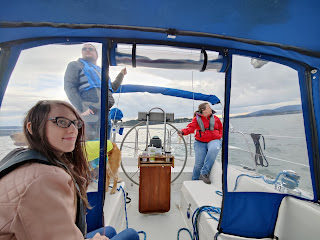We decided we needed some additional training on docking. On the 22, docking is not terribly difficult. Greg could stop the boat just by holding the bow pulpit or stanchion. But with the 320, trying to stop a 11,700 pound boat under diesel power just doesn't work the same way.
Shearwater University is a US Sailing instructional group run out of Cap Sante Marina in Anacortes. Their slip for Ardenna, their sail boat, was only about 40 feet from our slip. We ran into them several times while doing work on our boat. They do training on your boat, if you like. So we contracted to have Mark go out with us and give us some docking and maneuvering training. The night before, we had them help us get the boat turned around and moved to an easier slip to get into and out of.
The morning of our training we went to Fisheries Supply and West Marine and bought two Shaefer mid rail cleats and two 5/8" 35' docking lines (later adding two more). The mid rail cleats slide onto the 1.25" tracks, which takes no effort at all to install. Although the cleats were expensive, when you factor in time to install permanent cleats, they were cheap.
Shearwater teaches a single line docking technique. It's pretty slick. It's designed for having one pilot and one crew. It needs to be modified a bit for different conditions, depending on the wind direction and whether launching forward or toward the aft, and which side your prop walk takes you. For launching, essentially the scheme is to have the engine push against a single spring line at midship that is looped around the cleat and back to the mid rail cleat. Then all the other lines can be removed. With the wheel turned, that one line will pull the boat into the dock. The mate comes on board. The boat can then be put into neutral, the spring line untied, the boat put into gear, the spring line unlooped from the dock and you are underway.
Coming in, the mate goes onto the dock with the spring line. It is looped around a cleat but not locked. When the boat is at the right place on dock, it is placed into neutral. The spring line is locked. The wheel is turned and placed in gear at idle speed. The boat sucks right into dock and held in place by the single spring line. Now at leisure the entire boat can be made secure with forward and stern lines. Then the engine is shut off.
Docking with these techniques is so much less stressful. We put it to use immediately and with just a little practice it is working very well. There is only one step in docking and launching that has to be timed well, which is getting the spring line on and off the cleat. The rest can be done at leisure. Nobody is jumping on to a boat that is leaving the dock, which is much safer.




























